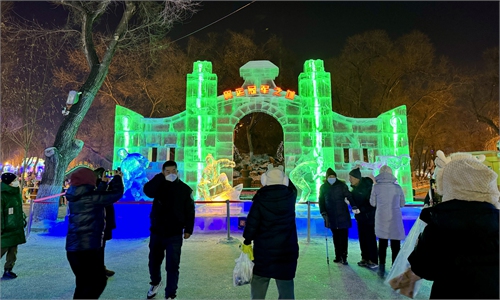Culture authorities scramble for tourists following Harbin phenomenon
Ice and snow fever signals fast tourism recovery in China

Tourists are seen at an ice amusement spot in sunset on the Songhuajiang River Harbin section in Harbin, northeast China's Heilongjiang Province, Jan. 7, 2024. Dubbed China's "ice city," Harbin has recently seen a tourism boom. An ice amusement spot, transformed from an ice collecting site out of use, has attracted lots of visitors to have fun here with ice packs scattered on the Songhuajiang River Harbin section. (Xinhua/Xie Jianfei)
The tourism phenomenon triggered by Harbin, the ice city in Northeast China's Heilongjiang Province, shows no sign of abating and most recently its popularity has led to a fierce competition among tourism authorities in several Chinese cities, as they strive to leverage the internet's potential to convert online engagement into real tourist footfall.
Starting from January 9, the official Douyin account of the Department of Culture and Tourism of Henan Province has seen an increase in the number of videos being posted, with 20 to 30 clips being released per day and a total of 112 in four days, enthusiastically showcasing its cultural and tourism resources. By posting videos such as "Shaolin Kung Fu" and "mutton stewed noodles" to show off its local cuisine, the account gained nearly one million followers within just a few days.
In January, North China's Shanxi and Central China's Henan provinces announced their partnership in tourism, achieving mutual exemption of admission tickets for 114 A-level scenic spots in six cities.
While culture and tourism authorities in Shanxi and Henan provinces are boasting their enriched tourism resources on social media, East China's Shandong Province, famous for being the birthplace of Confucius and the location of the famous Taishan Mountain and the Yellow River estuary, has also attracted much online attention.
The Department of Culture and Tourism in North China's Hebei Province changed their short video official name overnight, from "Hebei Tourism" to "Hebei Cultural and Tourism." This alteration was prompted by the fierce online competition to attract tourists, resulting in the phrase "cultural and tourism" gaining significant popularity across various social media platforms.
More interesting is that the video of the head of culture and tourism in Harbin's Acheng district dancing with performers from Harbin Ice-Snow World, the world's largest theme park of its kind, on short video platforms, has entertained millions of netizens.
These diligent efforts made by the local head of culture and tourism in Harbin to attract tourists to the city were joined by netizens across the country as they playfully boasted about the exceptional skills possessed by their own heads of culture and tourism bureaus, all in an effort to achieve similar success in their own cities.
Netizens from Southwest China's Sichuan Province, known for its giant panda bases, jokingly claimed that their head of local culture and tourism bureau has the extraordinary ability to "give birth to" giant pandas. While, netizens from Central China's Hunan Province proudly boasted that their head of cultural and tourism can devour a staggering 50 kilograms of red peppers. Hunan Province is renowned for its diverse pepper varieties and spicy cuisine, which locals take great pride in.
Netizens from Southwest China's Yunnan Province went as far as bragging that their head of cultural and tourism can consume three kilos of raw wild mushrooms. Yunnan is famous for its different types of wild mushrooms, some of which can be poisonous if not cooked properly.
With the rapid proliferation of social media, Harbin has swiftly become the most coveted tourist destination in the country. Recognizing this trend, cultural and tourism authorities aim to harness the power of the internet to transform online engagement into actual tourist visits.
Cities surrounding Harbin have also attempted to take advantage of the huge tourist flow brought with Harbin by frequently uploaded interesting videos.
Tourism in Harbin hasn't become popular overnight. It is a result of the long-term promotion of ice and snow sports in Northeast China, reflecting the booming popularity of China's ice and snow tourism, Jiang Yiyi, deputy head of the School of Leisure Sports and Tourism at Beijing Sport University, told the Global Times on Sunday.
Jiang believes it might be difficult to reproduce the popularity of Harbin tourism. Its popularity and the booming Zibo barbecue phenomenon in 2023 are the results of unintentional efforts. However, both places have achieved good interaction with the tourists.
These two major tourism events in China and the popularity of a grassroots basketball tournament known as Village BA are not only developed based on the tourism resources in these regions, but also achieved by actively grafting them with local culture, Jiang noted.
Industry observers noted that the key to turning one-time booming tourism into a persistent trend lies in the continuous cultivation of a pleasant destination to visit and fostering a warm-hearted hospitality.
In the beginning of this winter, Harbin has effectively addressed tourists' complaints regarding the organization and services of Harbin Ice-Snow World, as well as overcharging by local restaurants. This crisis management has left a positive impression of the city. Harbin has also taken the initiative to provide considerate services to tourists, media reports said. For example, numerous free warm and comfortable rest stations have been established at major tourist attractions, which have been well-received by visitors.
Both last year's Zibo barbecue and this year's ice and snow fever reflect the fast recovery of China's tourism industry. As winter, the traditional tourism off-season, draws new tourism fever, these events signal the fast tourism development in China, Jiang noted.



